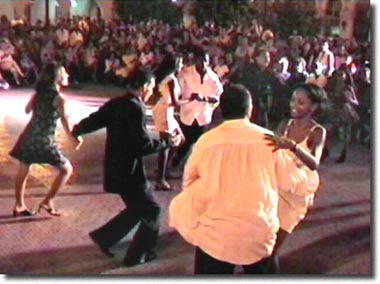11.3.7 Sauce.

The word “Salsa” means “seasoning,” and it has been publicly embraced as a word symbolically associated with flavor, joy, and the strength of life. In the musical world, it is recognized by a series of subgenres and rhythms, essentially Cuban.
The basic musical structure of Salsa is based on the Son, beginning with a simple melody and followed by a chorus of improvisation. A rhythmic component that forms the basis of Salsa is the clave rhythm, generally played on the claves. The most common Salsa clave rhythm is the so-called Son clave (2-3). Salsa is written in 4/4 time. Rhythmic sequences and phrase beginnings are used in the lyrics and instruments. The rhythmic patterns played on percussion instruments are rather complicated, often with different patterns playing simultaneously.
Many musicians, both composers and performers, have expressed their opinions about the origins of Salsa. Among them is Cuban singer Celia Cruz, who defined Salsa as follows: “Salsa is Cuban music by another name. It’s Mambo, Cha-Cha-Cha, Rumba, Son… all Cuban rhythms under one name.” Others, like author Ed Morales, claim that the origins of Salsa were based on the use of the trombone as a melodic element, the soloist, and a more aggressive sound than is typical in Cuban music. He also defines it as a new twist on traditional Cuban rhythms.
In general, traditional Cuban music is understood to be the origin of Salsa. Salsa’s predecessors are primarily considered to be Son and Mambo, in addition to the traditional Cuban Rumba rhythms: Guaguancó-Yambú-Columbia, Guaracha, and Bolero. Salsa’s most direct ancestor, however, is Cuban Son, a blend of Spanish and African influences inherited by the Cuban people. It is the Cuban musical genre that has most influenced Salsa, both in its instrumental format and its musical structure.
Salsa developed in the late 1970s and continued to evolve throughout the 1980s and 1990s. New instruments were incorporated into the instrumental format used for its performance. It also embraced new methods and musical forms, which were adapted to salsa.
Subgenres of salsa emerged and were created, such as romantic salsa. It was influenced by other musical genres, such as hip hop, which contributed to the evolution of salsa. Due to its worldwide spread, it has adopted distinct nuances and accents in various parts of the Spanish-speaking world.
Salsa has spread throughout the universe, constantly present in the music scene, and has become one of the most important genres of popular music in the world, while the stars of the genre are international celebrities.
Salsa is cultivated and can be found in various countries around the world such as: Santo Domingo, Haiti, Puerto Rico, Cayman Islands, Jamaica, Panama and Colombia, among many others.








